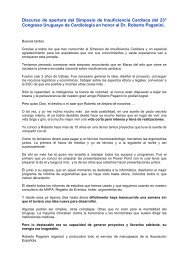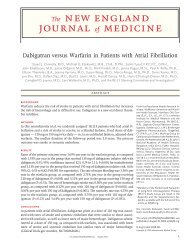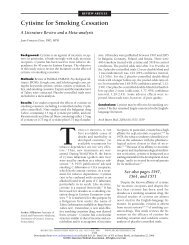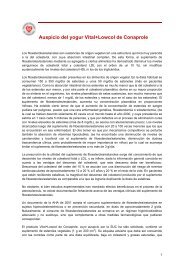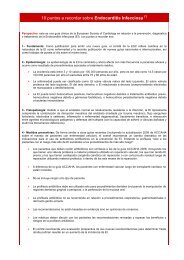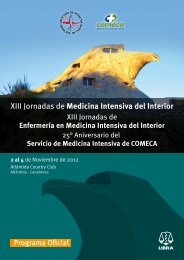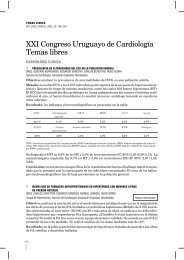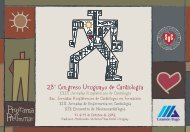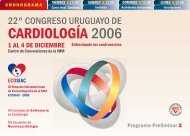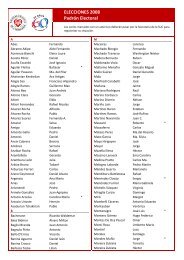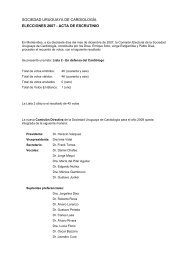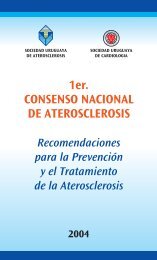Comité de Ecocardiografía - Sociedad Uruguaya de Cardiología
Comité de Ecocardiografía - Sociedad Uruguaya de Cardiología
Comité de Ecocardiografía - Sociedad Uruguaya de Cardiología
Create successful ePaper yourself
Turn your PDF publications into a flip-book with our unique Google optimized e-Paper software.
aguda <strong>de</strong>l infarto <strong>de</strong> miocardio y se separan los pacientes con un tiempo <strong>de</strong> <strong>de</strong>saceleración normal o seudo<br />
normal según tengan la Vp normal o diminuída ( < 45 cm/s). En el seguimiento a 12 meses, el grupo <strong>de</strong><br />
pacientes con patrón <strong>de</strong> llenado normal y Vp normal no tuvieron mortalidad, en tanto que el grupo con<br />
patrón seudonormal y Vp disminuída la mortalidad estuvo próxima al 50%. (Tabla 4).<br />
Tabla 3. Pronóstico <strong>de</strong> pacientes con IAM Tabla 4.- Pronóstico <strong>de</strong> pacientes con<br />
según relación E/Vp. IAM según patrón <strong>de</strong> llenado.<br />
Mortalidad a 35 días Sobrevida a 12 meses<br />
E/Vp < 1.5 98% Patrón <strong>de</strong> llenado normal Vp > 45 cm/s 100%<br />
E/Vp > 1.5 58% Patrón <strong>de</strong> llenado pseudonormal Vp < 45 cm/s 50%<br />
BIBLIOGRAFÍA<br />
1. García MJ, Thomas JD, Kliein AL. New Doppler echocardiographic applications for the study of diastolic<br />
function. J Am Coll Cardiol 1998;32:865-75.<br />
2. Appleton CP, Firstenberg MS, Garcia MJ, Thomas JD. The echo-Doppler evaluation of left ventricular<br />
diastolic function. Cardiology Clinics 2000;18:513-46.<br />
3. Brun P, Tribouilloy C, Duval AM, Iserin L, Meguira A, Pelle G, Dubois JL. Left ventricular flow propagation<br />
during early filling is related to wall relaxation: a color M-mo<strong>de</strong> Doppler analysis. J Am Coll Cardiol<br />
1992;20:420-32.<br />
4. Stugaard M, Smiseth OA , Risöe C, Ihlen H, . Intraventricular early diastolic fillinf during acute myocardial<br />
ischemia: assessment by multigated dolor M-mo<strong>de</strong> Doppler. Circulation 1993;88:2705-13.<br />
5. Stugaard M, Risöe C, Ihlen H, Smiseth OA. Intracavitary pattern in the failing left ventricular assessed by<br />
color M-mo<strong>de</strong> doppler echocardiography. J Am Coll Cardiol 1994; 24:663-70.<br />
6. García MJ, Palac RT, Malenka DJ, Terrell Patricia, Plehn JF. Color M-mo<strong>de</strong> Doppler flow propagation<br />
velocity is a relatively preload-in<strong>de</strong>pen<strong>de</strong>nt in<strong>de</strong>x of left ventricular filling. J Am Soc Echocardiogr<br />
1999;12:129-37.<br />
7. Takatsuji H, Mikami T, Urasawa K, Teranishi J, Onozuka H, Takagi C, Makita Y, Matsuo H, Kusuoka H,<br />
Kitabatake A. A new approach for evaluation of left ventricular diastolic function: spatial and temporal<br />
analysis of left ventricular filling flow propagation by color M-mo<strong>de</strong> doppler echocardiography. J Am Coll<br />
Cardiol 1996;27:365-71.<br />
8. Møller JE, Søn<strong>de</strong>rgaard E, Seward JB, Appleton CP, Egstrup K. Ratio of left ventgricular peak E-wave<br />
velocity to flow propagation velocity assessed by color M-mo<strong>de</strong> Doppler echocardiography in first myocardial<br />
infarction. Prognostic and clinical implications. J Am Coll Cardiol 2000;35:363-70.<br />
9. Møller JE, Søn<strong>de</strong>rgaard E, Poulsen SH, Egstrup K. Pseudonormal and restrictive filling patterns predict left<br />
ventricular dilation and cardiac <strong>de</strong>ath after a first myocardial infarction: a serial color M-mo<strong>de</strong> Doppler<br />
echocardiographic study. J Am Coll Cardiol 2000;36:1841-46.<br />
6. RECOMENDACIONES PARA LA MEDICIÓN DE LOS DIFERENTES PARÁMETROS<br />
Flujo <strong>de</strong> llenado <strong>de</strong>l Ventrículo Izquierdo por ETT<br />
§ Las mayores velocida<strong>de</strong>s a través <strong>de</strong> la válvula mitral son registradas cuando la muestra <strong>de</strong> volumen se<br />
ubica a nivel <strong>de</strong> los bor<strong>de</strong>s <strong>de</strong> las valvas abiertas en diástole. En esta región se <strong>de</strong>be <strong>de</strong>tectar el click <strong>de</strong><br />
apertura <strong>de</strong> la mitral, en tanto que el <strong>de</strong> cierre es muy poco audible o no se ve. Si no hay click, la muestra <strong>de</strong><br />
volumen está muy a<strong>de</strong>ntro <strong>de</strong>l VI, en tanto que si el click es ruidoso o la insuficiencia mitral está presente, la<br />
muestra está <strong>de</strong>masiado cerca <strong>de</strong>l anillo.1-5<br />
§ El tamaño <strong>de</strong> la muestra <strong>de</strong> volumen <strong>de</strong>be ser pequeño, entre 1 y 2 mm6,7 con un transductor <strong>de</strong> 2 a 2.5<br />
MHz.<br />
§ Utilizar Doppler pulsado en razón que el continuo no <strong>de</strong>be ser usado para medir los tiempos <strong>de</strong><br />
<strong>de</strong>saceleración mitral y <strong>de</strong> duración <strong>de</strong> la onda A.6,8,9<br />
§ Usar el Doppler color como guía para alinear el volumen <strong>de</strong> muestra <strong>de</strong>l DP paralelo al flujo <strong>de</strong> llenado<br />
ventricular. Hay que buscar la mayor velocidad teniendo en cuenta las cualida<strong>de</strong>s acústicas <strong>de</strong>l flujo laminar:<br />
espectro <strong>de</strong> banda estrecho conjuntamente con un silbido <strong>de</strong> cualidad musical y tono más alto. El enfoque 4<br />
cámaras apical generalmente es óptimo para alinear el flujo <strong>de</strong> entrada mitral paralelo al transductor.<br />
Muchas veces se requiere <strong>de</strong>splazar lateralmente la sonda porque el flujo se dirige hacia la pared<br />
posterolateral.6<br />
§ Usar filtros tan bajos como sean posibles.7<br />
§ Usar niveles <strong>de</strong> ganancia que no sean elevados.7<br />
§ Después <strong>de</strong> visualizar el llenado ventricular durante varios ciclos respiratorios para ver si hay variaciones, el<br />
registro se <strong>de</strong>be realizar en apnea espiratoria no forzada.6,7<br />
§ La ganancia <strong>de</strong>l ECG <strong>de</strong>be ubicarse para que el inicio y finalización <strong>de</strong> la onda P sean nítidos<br />
§ Velocidad <strong>de</strong> registro <strong>de</strong> 100 mm/seg.<br />
§ Se <strong>de</strong>ben promediar no menos <strong>de</strong> 3 latidos<br />
§ Cuando vamos a medir la duración <strong>de</strong> la onda A mitral, en algunos casos, su inicio y finalización se <strong>de</strong>finen<br />
mejor introduciendo algunos milímetros el volumen <strong>de</strong> muestra hacia el anillo mitral.6





